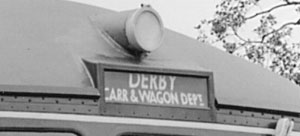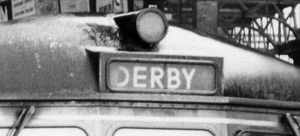Class 114 Derby 2-car DMUs
Cab Design

The chance was taken to incorporate updates from what was learned from the Derby Lightweight design, including the introduction of what became the standard Derby cab design, following feedback from the BTC that the Met-Camm idea of angled windows was more ashthetically pleasing than the cathedral-like cab windows of the Derby Lightweights.



The first image is a mock-up of the new Derby cab. Little else is known about this image other than it is dated late 1957, and in this condition it is unlikely to have been used as a mock-up before building the vehicles, although it's original purpose may have been that before being updated. Derby Works frequently produced cab mock-ups to participate in local galas and fairs etc. and this could be one purpose for this. Another could be for staff familiarisation as Derby also had a training school, and the cab interior looks pretty complete. One big difference in the mock-up is the visible door into the cab is hinged on the opposite side from normal.
This means the handrail is also on the opposite side from normal, and it shows this original type well which doubled as a drain tube for the gutters. These blocked easily and were later replaced by flat bar handrails identifiable as they were shorter top and bottom. The images on the left show the differences between the original (first picture) and replacement types (centre picture). The third type isn't a conventional handrail, but at waist height there is a commode handle as used on the passenger doors, and a short handrail underneath. This arrangement was fitted on 50001/56001 until at least the rail blue era.
50001
As well as the different handrails mentioned above, 50001 could be easily identified by a difference in the destination indicator box. Again following Met-Camm practice it was moved from the Lightweight postition of inside the centre cab window to above the centre cab window, protruding from the roof dome. On 50001 (the first image) this differed as it was slightly lower and squarer, the gutter breaking either side of it. Normally the gutter was continous (second image) and the destination indicator was slightly higher.


Missing top lamp

Not sure how widespread this was, but when E50018/E56018 were filmed in East Anglia for the British Transport Films "The Diesel Train Driver - Dealing With Faults" film, neither vehicle had the top marker light on the roof dome, they had a lighter white patch in the area it should be. They would later be fitted with the lamps.
The top lamps would be removed from many vehicles in later years.
Summary
Description: General
Description: Cab Design
Description: Power Train
Description: Exterior
Description: Interior
Coupling Code
Diagrams & Works Photos
Numbering & Driving Inst.
Liveries
Operations
Accidents
Refurbishment
Parcel Cars
Non-Passenger Use
Images
Details about preserved Class 114s can be found here.


